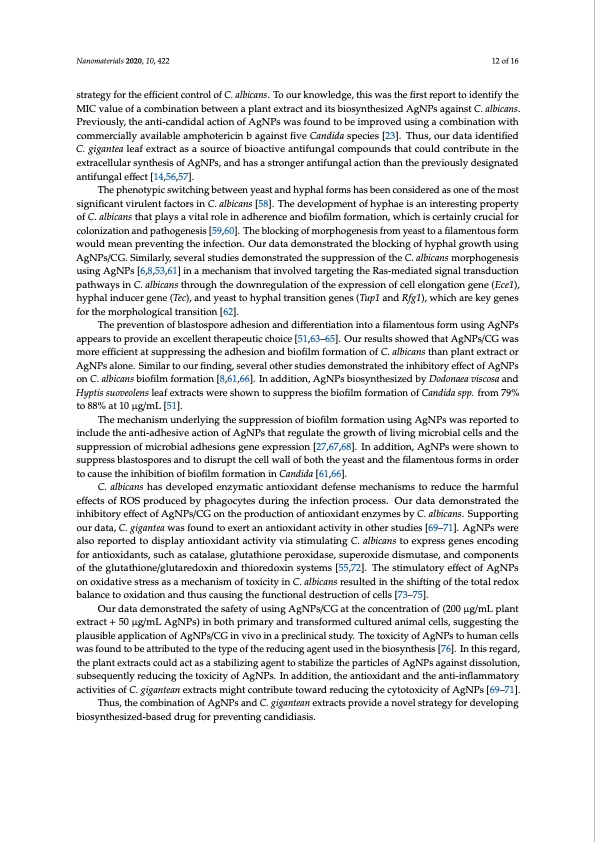
PDF Publication Title:
Text from PDF Page: 012
Nanomaterials 2020, 10, 422 12 of 16 strategy for the efficient control of C. albicans. To our knowledge, this was the first report to identify the MIC value of a combination between a plant extract and its biosynthesized AgNPs against C. albicans. Previously, the anti-candidal action of AgNPs was found to be improved using a combination with commercially available amphotericin b against five Candida species [23]. Thus, our data identified C. gigantea leaf extract as a source of bioactive antifungal compounds that could contribute in the extracellular synthesis of AgNPs, and has a stronger antifungal action than the previously designated antifungal effect [14,56,57]. The phenotypic switching between yeast and hyphal forms has been considered as one of the most significant virulent factors in C. albicans [58]. The development of hyphae is an interesting property of C. albicans that plays a vital role in adherence and biofilm formation, which is certainly crucial for colonization and pathogenesis [59,60]. The blocking of morphogenesis from yeast to a filamentous form would mean preventing the infection. Our data demonstrated the blocking of hyphal growth using AgNPs/CG. Similarly, several studies demonstrated the suppression of the C. albicans morphogenesis using AgNPs [6,8,53,61] in a mechanism that involved targeting the Ras-mediated signal transduction pathways in C. albicans through the downregulation of the expression of cell elongation gene (Ece1), hyphal inducer gene (Tec), and yeast to hyphal transition genes (Tup1 and Rfg1), which are key genes for the morphological transition [62]. The prevention of blastospore adhesion and differentiation into a filamentous form using AgNPs appears to provide an excellent therapeutic choice [51,63–65]. Our results showed that AgNPs/CG was more efficient at suppressing the adhesion and biofilm formation of C. albicans than plant extract or AgNPs alone. Similar to our finding, several other studies demonstrated the inhibitory effect of AgNPs on C. albicans biofilm formation [8,61,66]. In addition, AgNPs biosynthesized by Dodonaea viscosa and Hyptis suoveolens leaf extracts were shown to suppress the biofilm formation of Candida spp. from 79% to 88% at 10 μg/mL [51]. The mechanism underlying the suppression of biofilm formation using AgNPs was reported to include the anti-adhesive action of AgNPs that regulate the growth of living microbial cells and the suppression of microbial adhesions gene expression [27,67,68]. In addition, AgNPs were shown to suppress blastospores and to disrupt the cell wall of both the yeast and the filamentous forms in order to cause the inhibition of biofilm formation in Candida [61,66]. C. albicans has developed enzymatic antioxidant defense mechanisms to reduce the harmful effects of ROS produced by phagocytes during the infection process. Our data demonstrated the inhibitory effect of AgNPs/CG on the production of antioxidant enzymes by C. albicans. Supporting our data, C. gigantea was found to exert an antioxidant activity in other studies [69–71]. AgNPs were also reported to display antioxidant activity via stimulating C. albicans to express genes encoding for antioxidants, such as catalase, glutathione peroxidase, superoxide dismutase, and components of the glutathione/glutaredoxin and thioredoxin systems [55,72]. The stimulatory effect of AgNPs on oxidative stress as a mechanism of toxicity in C. albicans resulted in the shifting of the total redox balance to oxidation and thus causing the functional destruction of cells [73–75]. Our data demonstrated the safety of using AgNPs/CG at the concentration of (200 μg/mL plant extract + 50 μg/mL AgNPs) in both primary and transformed cultured animal cells, suggesting the plausible application of AgNPs/CG in vivo in a preclinical study. The toxicity of AgNPs to human cells was found to be attributed to the type of the reducing agent used in the biosynthesis [76]. In this regard, the plant extracts could act as a stabilizing agent to stabilize the particles of AgNPs against dissolution, subsequently reducing the toxicity of AgNPs. In addition, the antioxidant and the anti-inflammatory activities of C. gigantean extracts might contribute toward reducing the cytotoxicity of AgNPs [69–71]. Thus, the combination of AgNPs and C. gigantean extracts provide a novel strategy for developing biosynthesized-based drug for preventing candidiasis.PDF Image | Inhibition of Candidiasis Calotropis Silver Nanoparticles

PDF Search Title:
Inhibition of Candidiasis Calotropis Silver NanoparticlesOriginal File Name Searched:
nanomaterials-10-00422-v3.pdfDIY PDF Search: Google It | Yahoo | Bing
Turbine and System Plans CAD CAM: Special for this month, any plans are $10,000 for complete Cad/Cam blueprints. License is for one build. Try before you buy a production license. More Info
Waste Heat Power Technology: Organic Rankine Cycle uses waste heat to make electricity, shaft horsepower and cooling. More Info
All Turbine and System Products: Infinity Turbine ORD systems, turbine generator sets, build plans and more to use your waste heat from 30C to 100C. More Info
CO2 Phase Change Demonstrator: CO2 goes supercritical at 30 C. This is a experimental platform which you can use to demonstrate phase change with low heat. Includes integration area for small CO2 turbine, static generator, and more. This can also be used for a GTL Gas to Liquids experimental platform. More Info
Introducing the Infinity Turbine Products Infinity Turbine develops and builds systems for making power from waste heat. It also is working on innovative strategies for storing, making, and deploying energy. More Info
Need Strategy? Use our Consulting and analyst services Infinity Turbine LLC is pleased to announce its consulting and analyst services. We have worked in the renewable energy industry as a researcher, developing sales and markets, along with may inventions and innovations. More Info
Made in USA with Global Energy Millennial Web Engine These pages were made with the Global Energy Web PDF Engine using Filemaker (Claris) software.
Infinity Turbine Developing Spinning Disc Reactor SDR or Spinning Disc Reactors reduce processing time for liquid production of Silver Nanoparticles.
| CONTACT TEL: 608-238-6001 Email: greg@infinityturbine.com | RSS | AMP |